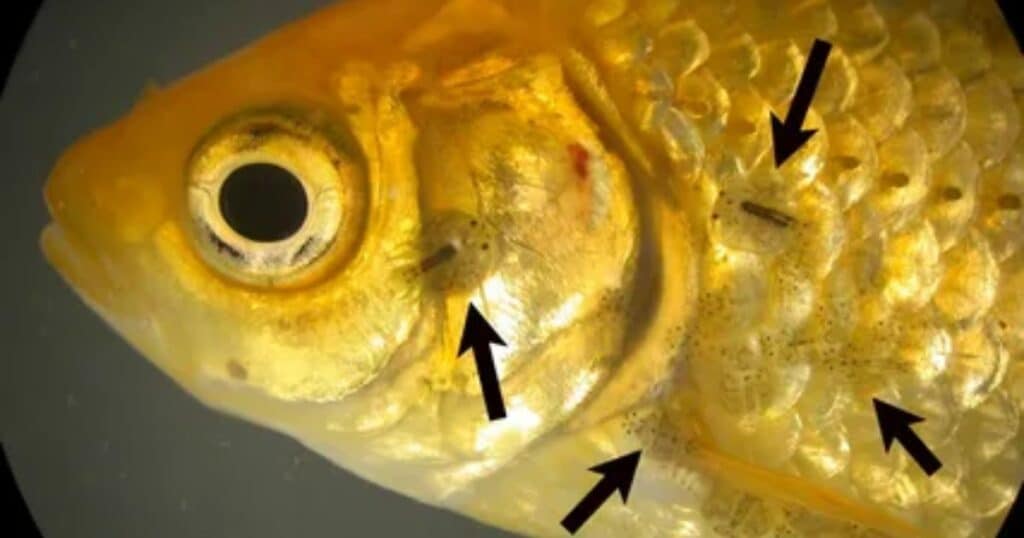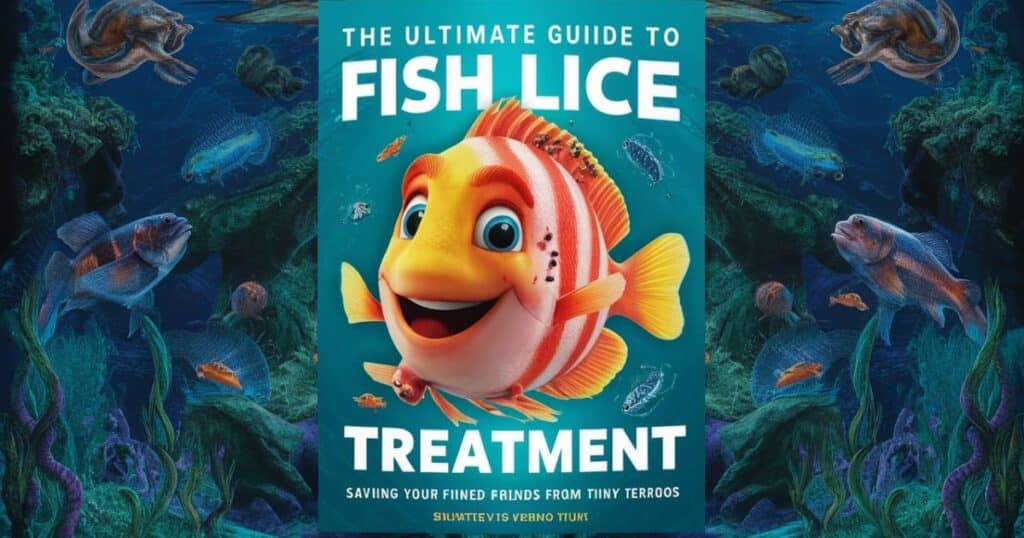Aquarium enthusiasts, gather ’round! If you’ve ever noticed your fish acting like they’re auditioning for an underwater version of “So You Think You Can Dance,” you might be dealing with a case of fish lice treatment. These aquatic parasites are no laughing matter, but don’t worry – we’re about to dive deep into the world of lice treatment in fish, arming you with everything you need to know to keep your underwater pals happy and healthy.
What Are Fish Lice?

Let’s start by getting to know our enemy. Fish lice, scientifically known as Argulus, are tiny crustacean fish ectoparasites that make life miserable for our aquatic friends. These miniature monsters are like the vampires of the fish world – they latch onto your fish and literally suck the life out of them. Not cool, right?
Argulus species are found in both freshwater and marine environments, making them a potential threat to a wide variety of fish. These fish parasites have a flattened, oval-shaped body that allows them to cling tightly to their host. They’re equipped with a pair of suction cup-like structures and a sharp, needle-like appendage used for feeding. Imagine a tiny, evil Roomba with a straw, and you’re not far off.
The life cycle of these crustacean pests is relatively simple but efficient:
- Eggs are laid on plants or other surfaces in the water
- Larvae hatch and immediately seek out a host fish
- They molt several times, growing larger with each stage
- Adults continue to feed and reproduce on the host fish
This cycle can repeat every 30-40 days, meaning a small problem can quickly become a big one if left unchecked.
“Fish lice are like uninvited guests at a pool party – they show up unexpectedly, cause a ruckus, and are incredibly hard to get rid of.” –
Dr. Finn Aquarius, Marine Biologist
Different species of fish may react differently to lice infestations. Some hardy species might tolerate a few lice without showing significant signs of distress, while others can quickly become overwhelmed. However, no fish is immune to the potential dangers of a severe infestation.
MORE POST: Aquarium Red Fish: Your Ultimate Guide To Vibrant Underwater Worlds
Spot the Trouble: Symptoms of Fish Lice Infestations
Before we jump into lice removal techniques, it’s crucial to recognize the signs of parasites in your fish. Early detection can make parasite treatment much more effective. Here are the key fish behavior changes and physical symptoms to watch for:
- The Fish Dance: Erratic swimming and flashing (quickly darting to one side)
- Body Language: Rubbing against objects and clamped fins
- Visual Cues: Spots, patches, and torn fins
- The Slime Factor: Increased mucus production
- Appetite Issues: Loss of interest in food
Let’s break these down further:
Erratic Swimming and Flashing
If your fish suddenly thinks it’s a break-dancer, it might be trying to shake off some unwanted passengers. Swimming abnormalities like darting, twitching, or rubbing against tank decorations are common signs of parasites.
Rubbing and Clamped Fins
Skin irritation from fish lice can cause your aquatic pals to try and scratch themselves by rubbing against rocks, plants, or the tank walls. You might also notice their fins held close to their body, a condition known as clamped fins.
Spots, Patches, and Fin Damage
Keep an eye out for small dark spots (which could be the lice themselves) or reddish patches on your fish’s skin. Fin damage is also common, as lice often attach near the base of fins, causing irritation and potential tearing.
Increased Mucus Production
Fish might increase their mucus production as a defense mechanism against the parasites. This can give them a slimy or cloudy appearance.
Behavioral Changes
Watch for any unusual behaviors, such as:
- Lethargy
- Loss of appetite
- Isolating from other fish
- Gasping at the water surface
If you notice any of these symptoms, it’s time to take action. Remember, early intervention is key to successful fish medication and recovery.
Zapping the Lice: Effective Fish Lice Treatment Strategies
Now that we’ve identified the enemy, it’s time to launch our counter-attack. Here’s your battle plan for delousing your finned friends:
1. Quarantine Time: Setting Up a Fish Spa
The first step in any effective aquarium treatment is isolation. Setting up a quarantine tank serves several purposes:
- Prevents the spread of lice to other fish
- Allows for targeted treatment
- Makes it easier to observe the affected fish
Your isolation aquarium or hospital tank doesn’t need to be fancy, but it should include:
- A filter (sponge filters work well for quarantine tanks)
- A heater to maintain proper temperature
- Some hiding spots for the fish to reduce stress
Avoid adding gravel or plants, as these can harbor parasites and make cleaning difficult. Remember, this is a temporary home for treatment, not a permanent vacation spot.
2. Medicine Mission: Chemical Warfare Against Lice
When it comes to fish medication, you’ve got a few options in your arsenal:
Medicated Baths: The Soak-and-Destroy Method
Medicated baths involve immersing your fish in a solution containing anti-parasitic medication for a specified period. Common medications include:
- Potassium permanganate
- Formalin
- Organophosphates
Always follow the manufacturer’s instructions carefully. Overdosing can harm your fish, while underdosing may not effectively eliminate the lice.
Quick Dips: Fast and Furious Lice Treatment
For more severe infestations or sensitive species, short dips in a stronger solution might be recommended. These therapeutic dips typically last only a few seconds to a few minutes.
Anti-parasitic Medications: Internal Defenses
Some treatments come in the form of food additives or water treatments that the fish absorb, fighting the parasites from the inside out. These can be effective but may take longer to show results.
Here’s a quick reference table for common chemical treatments:
| Treatment Type | Duration | Pros | Cons |
| Medicated Bath | 30-60 minutes | Effective for mild cases | May stress sensitive fish |
| Quick Dip | 30 seconds – 5 minutes | Powerful, fast-acting | Can be harsh, requires careful timing |
| Internal Medication | Ongoing (several days) | Less stressful for fish | Slower to show results |
Remember, medication application should always be done carefully and according to instructions. When in doubt, consult a veterinarian specializing in aquatic animals.
3. Natural Remedies: Eco-Friendly Lice Busting
For those who prefer a more natural approach to parasite elimination, there are several organic solutions and alternative therapies worth considering:
Salt Treatment: Making Life Salty for Lice
Aquarium salt (not table salt!) can create an environment that’s uncomfortable for lice while being safe for most freshwater fish. Here’s how to do it:
- Gradually add 1 tablespoon of aquarium salt per 5 gallons of water
- Maintain this concentration for 7-10 days
- Perform regular water changes, replacing the salt that’s removed
Note: Some fish species are sensitive to salt, so research your specific fish before trying this method.
Garlic Power: Flavoring the Water (and Repelling Lice)
Believe it or not, garlic can be a powerful ally in your fight against fish lice. It’s thought to boost the fish’s immune system and make them less appealing to parasites. Try these methods:
- Add a few drops of liquid garlic extract to the tank water
- Soak fish food in garlic juice before feeding
Water Flow Tricks: Creating an Anti-Lice Current
Increasing water movement in your tank can make it harder for lice to attach to your fish. Consider adding:
- An air stone for increased oxygenation and water movement
- A powerhead to create stronger currents
While these holistic fish care methods can be effective, they may not be enough for severe infestations. Always monitor your fish closely and be prepared to use more aggressive treatments if necessary.
An Ounce of Prevention: Keeping Fish Lice at Bay

As with most things in life, prevention is better than cure when it comes to fish lice. Here are some key preventative measures to incorporate into your aquarium management routine:
1. New Fish on the Block: Quarantine Procedures
Every new addition to your aquatic family should go through a quarantine period. This preventive monitoring helps ensure that you’re not introducing parasites or diseases to your main tank. Here’s how to set up an effective quarantine process:
- Set up a separate observation tank with minimal decoration
- Keep new fish in this tank for 2-4 weeks
- Observe for any signs of illness or parasites
- Treat any issues before introducing the fish to the main tank
2. Squeaky Clean: Maintaining a Lice-Free Environment
Good aquarium maintenance is crucial for preventing fish lice and other parasites. Here’s a checklist for keeping your tank in top shape:
- Perform regular water changes (10-20% weekly for most tanks)
- Vacuum the gravel to remove waste and uneaten food
- Clean filter media according to manufacturer instructions
- Test water parameters regularly and address any issues promptly
Remember, cleanliness measures aren’t just about aesthetics – they’re a crucial part of disease prevention.
3. Eagle Eyes: Regular Fish Health Inspections
Make it a habit to really observe your fish during feeding times or other daily interactions. This proactive care can help you spot potential issues early. Here’s what to look for:
- Changes in coloration
- Unusual swimming patterns
- Signs of physical damage or irritation
- Changes in appetite or behavior
Keep a journal of your observations to help track any changes over time. This can be invaluable information if you need to consult a veterinarian.
4. Fish Friend or Foe? Choosing Compatible Tank Mates
Creating a harmonious habitat involves more than just throwing a bunch of pretty fish together. Research each species before adding them to your tank, considering factors like:
- Size and temperament
- Water parameter requirements
- Dietary needs
- Known susceptibility to parasites
Some fish species are more resistant to lice than others, making them good choices for a community aquarium. Others may be more susceptible or even carry parasites without showing symptoms, potentially infecting your other fish.
5. No Crowds, Please: Proper Fish-to-Tank Ratios
An overcrowded tank is a stressed tank, and stressed fish are more susceptible to parasites and diseases. While the old “inch of fish per gallon of water” rule is a good starting point, it’s not a one-size-fits-all solution. Consider:
- The adult size of your fish species
- The bioload (waste production) of different species
- The efficiency of your filtration system
A well-balanced tank with appropriate stocking levels is key to maintaining aquatic wellness and preventing issues like fish lice infestations.
Conclusion: Your Action Plan for Lice-Free Living
Congratulations, aquarium aficionado! You’re now armed with the knowledge to tackle fish lice head-on. Let’s recap the key points of our lice treatment in fish battle plan:
- Stay vigilant: Regular observation is your first line of defense
- Act fast: Early intervention can prevent a full-blown infestation
- Choose your weapons wisely: Whether chemical or natural, use treatments appropriate for your fish and situation
- Prevention is key: Maintain a clean, well-balanced tank to keep lice at bay
- Keep learning: The world of aquarium care is always evolving, so stay curious and open to new information
Remember, dealing with fish lice isn’t a one-time event – it’s an ongoing process of care and maintenance. By incorporating these practices into your regular aquarium management routine, you’ll create a thriving, healthy environment for your underwater friends.
So go forth, fish enthusiasts! Armed with this knowledge, you’re ready to create a lice-free paradise for your finned companions. Your fish will thank you – maybe not with words, but with vibrant colors, active behavior, and the occasional bubble kiss. Happy fish keeping!
ALSO READ THIS POST: Ten Great Fish For 2.5 Gallon Nano Tanks
FAQ’s
What is the best treatment for fish lice?
The most effective treatment for fish lice typically involves a combination of quarantine and medication. Medicated baths containing ingredients like potassium permanganate or organophosphates are often recommended. For severe cases, a veterinarian may prescribe stronger treatments or suggest a series of short dips in more concentrated solutions.
How to remove lice from fish?
Removing fish lice involves a multi-step process. First, quarantine the affected fish in a separate tank. Then, apply appropriate medication through baths, dips, or food additives as directed. Finally, maintain excellent water quality and continue treatment for the recommended duration to ensure all life stages of the lice are eliminated.
What is the lifespan of lice in fish?
The lifespan of fish lice varies depending on the species and environmental conditions. Generally, the entire life cycle from egg to adult can take 30-40 days. Adult lice can live for several weeks to a few months on a host fish, continuously reproducing during this time.
Can fish lice infect humans?
Fish lice are species-specific parasites and do not infect humans. While they may occasionally attach to human skin if handled, they cannot survive or reproduce on humans. Any attachment is temporary and typically causes no harm beyond minor irritation.
How do you know if your fish has lice?
Signs of fish lice include visible parasites on the fish’s body, erratic swimming or flashing behavior, increased rubbing against objects, red patches or sores on the skin, clamped or damaged fins, and increased mucus production. You may also notice changes in appetite or overall behavior of the affected fish.
Do fish lice hurt fish?
Yes, fish lice can cause significant harm to fish. They feed on the fish’s blood and bodily fluids, causing physical damage, stress, and weakening the fish’s immune system. Severe infestations can lead to secondary infections, anemia, and even death if left untreated.

Davin Connor is an experienced author with 3 years in pets writing. Known for concise, informative content, he shares expertise on pet care, behavior, and health through his engaging articles.






